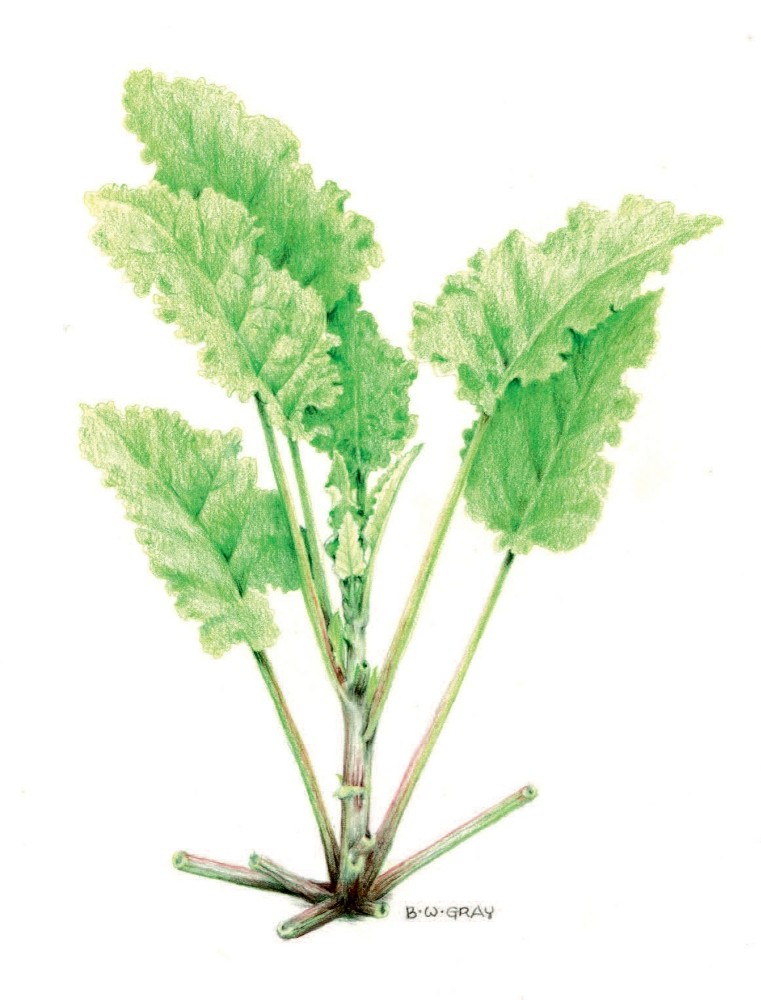Burdock (Arctium spp.) produces the annoying round burs that get stuck to your socks in the fall. (The fellow who invented Velcro™, George de Mestral from Switzerland, got the idea from the curved barbs on those burs, by the way.) Despite its prickliness, this plant is a tasty and nutritious wild vegetable, highly valued in Asian and macrobiotic cuisine, and is often easy to find in large patches. You are most likely to encounter burdock plants along the sunny edges of farm and athletic fields and pathways.
Two common species in the Northeast are common burdock (Arctium minus) and (Arctium lappa), which are both of Eurasian (non-native) origin. Greater burdock is usually considerably larger in every respect than common burdock.
Burdock is a biennial plant, which means it typically has a two-year life cycle. During the first year, the plant germinates from seed in spring and quickly grows a whorl of large, cordate (heart-shaped) leaves a foot or more long, which send the sun’s energy down into what eventually becomes an enormous, beige-colored taproot. During the second spring, the plant uses the energy stored in that taproot to produce a flower stalk that grows to 3 feet or taller, followed by magenta-colored flowers that eventually mature into the spherical burs holding the seeds. After producing seeds, the plant dies.
While burdock plants bear a superficial resemblance to unrelated rhubarb, the undersides of burdock leaves are finely wooly, whereas rhubarb leaves are smooth. Another distinction is that burdock petioles (leaf stalks) are green (sometimes streaked with purple) and ridged like celery stalks, while rhubarb petioles are smooth, glossy, and reddish.
Burdock root is used for both food and medicine, and according to Vermont-based herbalist Rosemary Gladstar, “is quite simply one of the safest, tastiest, and most effective detoxifying and cleansing herbs in Western and traditional Chinese medicine.” Its medicinal values include blood and liver cleansing and the alleviation of skin problems such as acne and psoriasis, along with reputed anti-cancer and antitumor properties. Burdock root has an earthy flavor, similar to artichoke, although burdock has a starchier texture. Burdock and artichoke are both members of the sunflower family (Asteraceae). The roots of a cultivated form of greater burdock are often sold in Asian and other specialty produce markets, usually under its Japanese name “gobo.”
The best time to gather wild burdock roots is from the latter half of the plant’s first growing season up until the very beginning of the second year, generally late April, when the second-year leaves are just beginning to show. Unlike a carrot, though, you can’t simply yank up a burdock root by its leaves, as it will break. You’ll have to dig it up, which is a lot of work, as the roots are more than a foot long. The standard advice is to find a spot where several large plants are growing near each other; dig one deep hole next to the roots and excavate them from the side. The top few inches of the roots tend to be gnarly and harder to clean (and less tasty), so you might want to use only the lower portion.
An easy way to prepare burdock roots for eating is to wash them (no need to peel), cut into ½-inch rounds, and boil in salted water until tender (about 15 minutes).
That said, I am too lazy to dig up burdock roots. Instead, I wait until the latter part of spring, when the second-year plants begin to produce flower stalks. Harvest the stalks when they are 1 to 2 feet high and still growing taller (well before the flowers show up). Once you get the bloom stalks home, peel or trim off their outer rind, which tends to be stringy and bitter. Chop the peeled stalks into ½-inch rounds and boil them in salted water until tender (about 7 minutes). While these are a fine vegetable as is, the boiled burdock flower stalk rounds are also excellent thrown into spaghetti sauce. They may also be substituted for artichoke hearts in many recipes, such as the one in which you mix them with mayonnaise, Parmesan cheese, and breadcrumbs, bake in the oven, and then serve with crackers. Boiled burdock flower stalk rounds freeze very well, and you can store them in a freezer bag for at least a year for later use. I have also made a Sicilian dish called Carduni with burdock petioles. To do this, chop up and boil until tender, mix with Parmesan cheese, breadcrumbs, and a beaten egg, form it into patties, and then fry them in a skillet in olive oil until golden on both sides.


